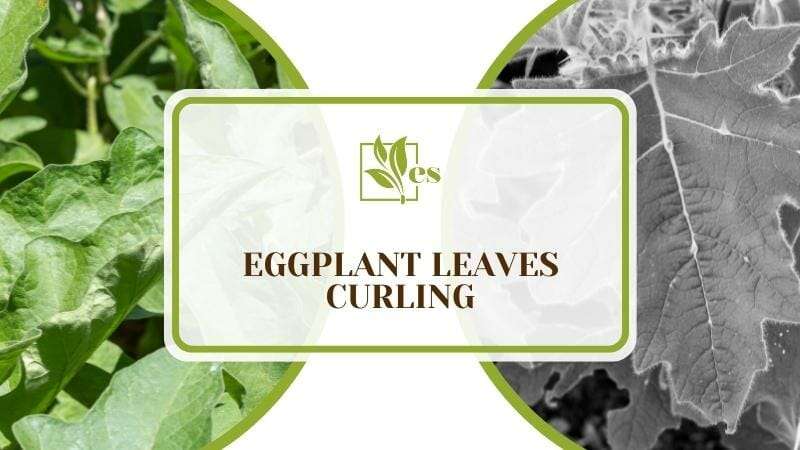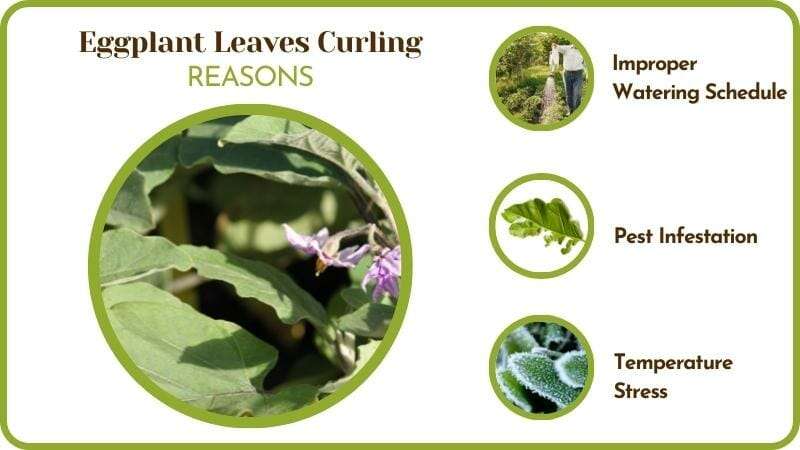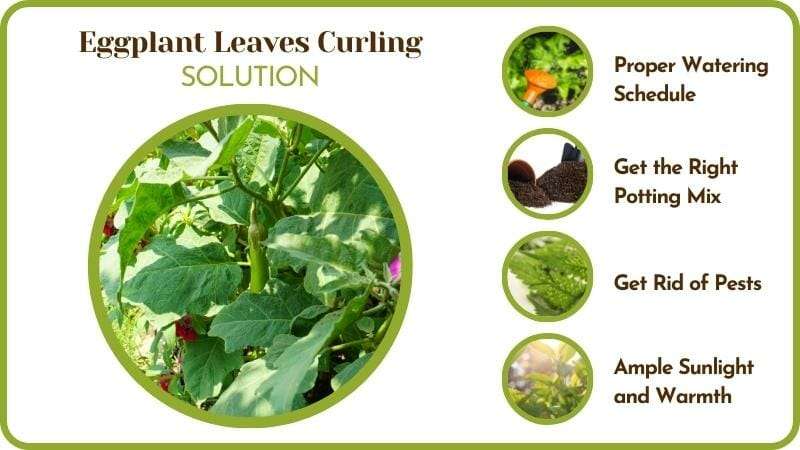Eggplant leaves curling is an issue that shows your plant has been infested with pests or diseases, has been improperly watered, or it’s not received the right amount of light.
It is an indication that the plant has been subject to some sort of stress and if not tackled soon it can hamper the overall health of the plant.
In this complete one-stop guide, our experts list the probable causes for the curling of the leaves. We also provide you with some perfect solutions and techniques to tackle the issue and also prevent its future occurrence, so read on.
Why Are Eggplant Leaves Curling?
💥 Eggplant leaves typically curl when they are subject to stress conditions such as over or under-watering, less or overexposure to light, bacterial and fungal diseases, or house plants pest infestations such as aphids or mites.
Apart from curling, the foliage of the plant may also be turning yellow, have white spots on the foliage, and overall look weak and limp. If you notice these signs it is time you look at the care aspects of the plant and figure out where exactly you are going wrong.
– Improper Watering Schedule
One of the most common causes for the leaves to curl is an improper watering schedule inclusive of both under as well as over-watering of the plant. Underwatering makes the soil dry and cracks up the top layer.
It prevents oxygen from being absorbed by the roots, thus there isn’t enough for the plant to thrive and regulate its photosynthesis process. More symptoms that dry soil will result in are drying up of the leaves, browning tips, and thin brittle foliage.
At the same time, over-watering the plant is going to be a threat to it as well. The plant seldom likes excessive moisture at the roots, which again, prevents the smooth transition of oxygen to the roots. As you water it more than necessary, it puts the plant at risk of getting infected by fungal and bacterial diseases.
Soggy soil attracts mold and algae which can feast on the nutrients in the soil otherwise required by the plant and you may notice a foul smell if the plant has developed root rot apart from the curling of the leaves.
– Pest Infestation
Pests such as Cucumber beetles, Earwigs, Aphids, cutworms, whiteflies, potato beetles, snails, spider mites, and slugs are common insects that infect the plant. These pests occur in clusters and can easily spread through the plant foliage.
They drain out the plant fluid making the stem and leaves go limp along with curling. You will find them on the underside of leaves where the eggs can be seen in clusters. What these pest eggs do is that they harm the leaves, and the leaves would degenerate: the first key aspect would be for the leaves to curl.
Over time and if ignored, pests infestations can become so severe that they can hamper overall health, killing the plant in its entirety. Flea beetles especially chew on tender and small leaves and make tiny holes all over them, thus causing intensive damage to the plant.
– Fungal and Bacterial Infestation
Curling of leaves can happen if the eggplant has been infected with any one of these diseases. Blossom end rot is a fungal growth caused because of overwatering. The bacterial wilt virus makes the leaves turn yellow and also wilts them like a curl. Verticillium wilt virus is soil-borne and apart from curling, they make the foliage wilt as well.
Southern blight yet again is caused by excess moisture and affects the crown of the root. If you notice white spots on the stems and the soil surrounding the plant apart from the curling, it is Mold that has affected the plant. All these are plant diseases apart from curling the leaves can also damage the plant completely and can result in its death.
– Sunlight Issues
Have you placed your spot in a spot where it isn’t receiving ample sunlight? Then you will have to reconsider moving it if you spot the curled-up leaves.
In addition, the eggplant, or all plants that bear vegetables in general, requires an environment where they can receive full sunlight. They seldom like to be in dark, dingy, and shady spots and react by curling their leaves.
– Temperature Stress
Eggplants thrive in moderate temperatures and any exposure away from this range will put the plant under stress. A rise in temperature above the normal range will result in not only the curling of leaves but also brown spots, making the flowers and fruits immaturely drop.
Moreover, in low temperatures and when exposed to frost, chilly winds, and cold drafts, the plant tissues can suffer extensive damage. You may also notice a delay in flowering apart from the curling. Eggplants love a certain level of warmth and under ideal temperatures, they thrive with full foliage producing adequate purple fruits.
– Incorrect Potting Soil and Container
The eggplant will not tolerate heavy clayey or loamy soil as these types tend to retain a lot of moisture, draining out the excess very slowly. On the other hand, note that if your soil is not light and porous it results in a stressful condition for the plant and you are bound to see it curl up slowly but surely and it would even wilt.
Additionally, check to see if your pot has proper drainage holes, or if they have been blocked by debris, gravel, or stones. However, a pot or container with poor drainage holes keeps the roots waterlogged. Both these conditions are detrimental to the health of the plant and over time can result in their death.
How To Stop Eggplant Leaves From Curling
To stop eggplant leaves from curling, you have to maintain a proper watering schedule, get the right potting mix, tackle any plant virus that it might have caught, get rid of any pests, maintain the right sunlight, and try to add any companion crops to help it grow stress-free.
– Maintain a Proper Watering Schedule
The eggplant prefers just a light amount of moisture, thus you have to avoid both situations of over as well as under-watering. The best way to do this is to maintain a proper watering schedule. Water the plant up to an inch per week just to keep the soil moist.
To know whether you have to add some water, do a simple finger test. Press your finger into the soil and feel for moisture. If it feels wet, refrain from adding in more. Alter the schedule as per the climate by scaling back in winter and watering the plant twice a week in winter.
– Get the Right Potting Mix
Use a well-draining and light potting mix with peat and perlite. This will keep the soil aerated and will prevent water logging at the roots. You could also throw in some orchid bark or worm castings to improve drainage.
Additionally, include organic compost such as vermicompost to increase the nutritional content in the soil. Also ensure the pot or container the plant is placed in has proper drainage holes to easily drain out excess water, preventing roots from sitting in excessive moisture.
– Tackle Plant Virus
The best way to tackle plant viral and bacterial infections is to prevent their occurrence because they might have caught it in a different way, one of which would be by cross-contamination. Always use sterile soil, pot, or container for growing your plant. Before you prune sections of the plant, ensure you sterilize your tools with a diluted solution of isopropyl alcohol.
Treat any infection as soon as you spot them, you might want to snip away affected portions and yellow leaves and dispose of them away from the rest of the plant foliage. For bacterial or fungal infections spray an organic fungicide or a solution of baking soda on the affected spots.
On the other hand, you must note that if it is a viral infection they do not have a cure, thus the only way to tackle them is to get rid of the plant as soon as possible.
– Get Rid of Pests
Pests need to be tackled as soon as spotted, before they spread across the plant, damaging foliage and making them go limp. As soon as you spot the clusters, isolate the eggplant to prevent the spread to nearby houseplants. In case of minor infestations, snip away the affected portion and discard them right away.
Spray a jet of water so that the pests can fall off the foliage. For more severe infestations, use an organic solution of neem oil whose odor repels the pests. Additionally, commercially available insecticides can also be used to get rid of them.
– Ample Sunlight and Warmth
The eggplant requires moderate temperatures between70 degrees Fahrenheit to 85 degrees Fahrenheit. Place the plant in your garden where there is bright light throughout the day.
On average, you will have to provide the plant with a minimum of six hours of light each day. Move the plant indoors in winter away from cold drafts and frost. In extreme summers place a garden sheet over the plant to protect it from the excessive heat and harsh rays of the sun
– Try Companion Crops
Planting companion crops is a practice where other plants are paired side by side with the eggplant. This practice is beneficial as it can deter pests, give the plant nutrient and mineral support and reduce weeds around it.
Grow any one of these companion plants with your eggplant to keep the foliage thriving and healthy, along with producing bountiful purple vegetables. Companions for the eggplant are cucumbers, lettuce, tomatoes, cabbage, potatoes, beans, marigolds, and nasturtium.












